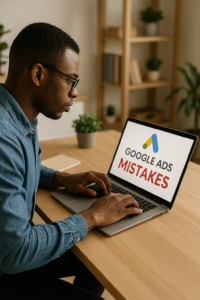Why Your Best Marketing Campaign Is Probably Invisible (And Why That’s Per
Discover why the most effective marketing campaigns work invisibly behind the scenes. Learn how subtle, invisible marketing strategies drive better results than loud promotional tactics in 2025.
In an era where consumers are bombarded with over 10,000 brand messages daily, the marketing campaigns that scream the loudest are often the ones ignored the fastest. Meanwhile, the most successful brands are mastering something counterintuitive: invisible marketing. These are campaigns so seamlessly integrated into the customer experience that they don’t feel like marketing at all—and that’s precisely why they work.
The Paradox of Modern Marketing Visibility
Traditional marketing wisdom has always emphasized visibility: bigger billboards, louder commercials, more intrusive pop-ups. But we’ve reached a saturation point where visibility has become synonymous with annoyance. According to recent consumer behavior research, 86% of consumers now actively skip or block traditional advertisements, and ad blindness has become a documented psychological phenomenon.
The invisible marketing campaign represents a fundamental shift in how brands communicate value. Rather than interrupting customers with promotional messages, these campaigns create value first, often without the customer realizing they’ve encountered marketing at all. Think of Spotify’s personalized playlists, which feel like a service feature but are sophisticated data-driven marketing tools that increase engagement and subscription conversions by over 40%.
What Makes Marketing “Invisible”?
Invisible marketing isn’t about being secretive or deceptive—it’s about being so relevant and valuable that the marketing becomes indistinguishable from the product or service experience itself. These campaigns share several key characteristics:
Contextual Relevance: Invisible marketing appears at exactly the right moment in the customer journey. When you’re researching vacation destinations and a travel blog offers a perfectly timed downloadable packing checklist, that’s invisible marketing. It doesn’t feel like an advertisement because it solves an immediate need you already have.
Value-First Approach: Instead of asking for attention, invisible campaigns earn it by providing genuine value. HubSpot’s comprehensive marketing guides are a prime example—thousands of pages of free, high-quality content that positions the brand as an authority while subtly demonstrating their platform’s capabilities.
Native Integration: The best invisible campaigns blend seamlessly into the platforms and contexts where they appear. Instagram’s shopping features don’t interrupt the browsing experience; they enhance it by making interesting products instantly accessible. This native integration creates a frictionless path from discovery to purchase without feeling transactional.
Personalization Without Intrusion: Modern consumers expect personalization, but they reject invasive targeting. Invisible marketing walks this fine line by using data intelligently to create relevant experiences without making customers feel surveilled. Netflix’s recommendation engine exemplifies this balance—it’s clearly algorithmic, yet it feels helpful rather than creepy.
Why Invisible Marketing Outperforms Traditional Campaigns
The effectiveness of invisible marketing isn’t just anecdotal—it’s backed by substantial data. Research from Forrester indicates that content marketing (a form of invisible marketing) generates three times more leads than traditional outbound marketing while costing 62% less. But the reasons go deeper than mere cost efficiency.
Trust Through Subtlety: When marketing doesn’t feel like marketing, it bypasses the natural skepticism consumers have developed toward advertising. A case study featured by the Content Marketing Institute showed that educational content from brands is trusted 50% more than traditional advertisements, even when consumers know the brand created it.
Longer Engagement Windows: Invisible campaigns often take the form of tools, content, or experiences that customers return to repeatedly. Red Bull’s extreme sports content empire doesn’t just advertise energy drinks—it created an entire media company that fans engage with regularly, building deep brand affinity over time. This sustained engagement is impossible with traditional campaign approaches that focus on momentary attention capture.
Organic Amplification: When marketing provides genuine value, people share it willingly without incentive. The most successful invisible campaigns create assets worth sharing for their own merits. Dove’s Real Beauty campaign succeeded not because of ad spend, but because it sparked authentic conversations about beauty standards, generating billions in earned media value.
The Psychology Behind Invisible Marketing Success
Understanding why invisible marketing works requires examining consumer psychology. The human brain is hardwired to detect and resist persuasion attempts—a phenomenon psychologists call “persuasion knowledge.” When we recognize something as an advertisement, we automatically raise our critical defenses, scrutinizing claims and discounting messages.
Invisible marketing succeeds by activating different psychological pathways. Instead of triggering persuasion resistance, it activates reciprocity (when you receive value, you feel inclined to give back), authority (valuable expertise positions the brand as trustworthy), and social proof (when marketing creates shareable experiences, it leverages peer influence).
The concept of “flow state” is also crucial. Psychologist Mihaly Csikszentmihalyi’s research on flow shows that people are most receptive and engaged when activities match their skill level and provide clear goals without friction. Invisible marketing maintains flow by integrating seamlessly into whatever the user is already doing, whether that’s browsing social media, researching solutions, or consuming entertainment.
Real-World Examples of Invisible Marketing Excellence
IKEA’s Augmented Reality App: Rather than pushing advertisements for furniture, IKEA created an AR tool that lets customers visualize products in their actual homes. This solves a real problem (uncertainty about fit and appearance) while naturally leading to purchases. The marketing is completely invisible—customers see it as a helpful tool, not a sales pitch.
Glossier’s Community-Driven Product Development: The beauty brand built an empire on invisible marketing by turning customers into co-creators. By actively incorporating customer feedback into product development and sharing that process transparently, Glossier’s marketing became indistinguishable from its product strategy. Customers felt ownership and naturally became brand advocates.
Slack’s Freemium Model: Slack’s entire go-to-market strategy is invisible marketing. By offering robust free functionality and letting the product’s value speak for itself, Slack eliminated traditional sales friction. Teams adopt Slack because it solves communication problems, not because they were convinced by marketing messages. The conversion from free to paid happens organically as usage grows.
Airbnb’s Magazine and Experiences: Airbnb extended beyond accommodation booking into lifestyle content and curated experiences. Their beautifully produced magazine and experience marketplace don’t obviously sell room bookings, but they reinforce the brand’s positioning around belonging and adventure, creating emotional connections that drive booking decisions invisibly.
Implementing Invisible Marketing in Your Strategy
Transitioning to invisible marketing requires a fundamental mindset shift from campaign thinking to ecosystem thinking. Instead of asking “What message should we push?” ask “What value can we provide that naturally aligns with our business goals?”
Start with Customer Jobs-to-be-Done: Use the Jobs-to-be-Done framework to understand what customers are actually trying to accomplish. Your invisible marketing should help them do those jobs better, with your product or service as a natural solution.
Build Owned Media Assets: Create content, tools, or platforms that have inherent value independent of immediate conversion goals. This might be a comprehensive resource library, an industry benchmark report, a useful calculator, or an entertaining podcast. These assets work invisibly over time, building authority and attracting customers in research mode.
Optimize for Dark Social: Much of the most powerful marketing happens in “dark social”—private messages, email, and group chats where sharing isn’t publicly tracked. Create assets worth sharing in these private channels by focusing on utility and entertainment value rather than promotional messaging.
Measure Differently: Invisible marketing requires different metrics than traditional campaigns. Look beyond immediate conversions to engagement depth, return visit frequency, organic sharing rates, and long-term customer value. Tools like Google Analytics 4 can track these more nuanced engagement patterns.
Integrate with Product Experience: Work closely with product teams to identify opportunities where marketing can enhance rather than interrupt the user experience. The most powerful invisible marketing often lives within the product itself, guiding users toward value realization and expansion opportunities naturally.
The Future of Invisible Marketing
As artificial intelligence and machine learning advance, invisible marketing will become even more sophisticated. Predictive personalization will enable brands to anticipate needs before customers articulate them, providing value at precisely the right moment. The line between product and marketing will continue to blur as experiences become more adaptive and context-aware.
Privacy regulations like GDPR and CCPA are actually accelerating the invisible marketing trend. As third-party tracking becomes more restricted, brands must build direct relationships through value exchange rather than surveillance. This regulatory environment favors strategies that earn attention through utility rather than exploit it through data.
The most forward-thinking brands are already preparing for a cookieless future by investing in first-party data strategies and value-driven marketing ecosystems that don’t depend on invasive tracking. These approaches align perfectly with invisible marketing principles—creating experiences so valuable that customers willingly engage and share information in exchange for continued value.
The Counterintuitive Power of Not Being Seen
The greatest marketing paradox of our time is that the less your marketing looks like marketing, the more effective it becomes. In a world oversaturated with promotional messages, invisibility is the ultimate competitive advantage. By focusing on creating genuine value, integrating seamlessly into customer contexts, and earning attention rather than demanding it, invisible marketing campaigns achieve what loud, aggressive campaigns cannot: they build trust, drive engagement, and convert customers who don’t even realize they’ve been marketed to.
Your best marketing campaign probably is invisible—and if it isn’t yet, it should be. The brands that master this approach won’t just outperform competitors in the short term; they’ll build sustainable competitive advantages based on customer relationships rather than promotional budgets. In the attention economy, sometimes the best way to be seen is to stop trying to be visible at all.
References and Sources
- Marketing Dive – Consumer Behavior Research: https://www.marketingdive.com
- HubSpot – Inbound Marketing Resources: https://www.hubspot.com
- Forrester Research – Content Marketing ROI Studies: https://www.forrester.com
- Content Marketing Institute – Trust and Engagement Metrics: https://contentmarketinginstitute.com
- Christensen Institute – Jobs-to-be-Done Theory: https://www.christenseninstitute.org
- Google Analytics – Advanced Measurement: https://analytics.google.com
- Nielsen Norman Group – User Experience Research: https://www.nngroup.com
- Harvard Business Review – Marketing Strategy: https://hbr.org



